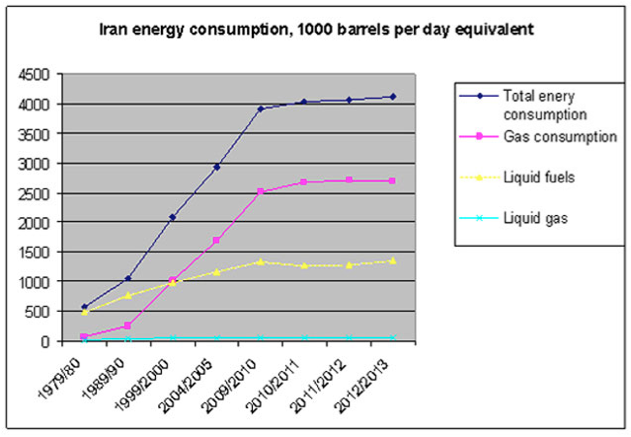Iran’s Fragile Energy Security
Iran’s primary energy consumption reached 1.6 billion barrels of oil equivalent (OE) last year, 141 million barrels OE more than the previous year. Currently, statistics indicate an increase in the usage of all energy carriers, which includes natural gas and gasoline.
Though Iran sits on 33.6 trillion cubic meters of gas and 158 billion barrels of recoverable crude oil, for a population of 78 million, consuming 1.6 billion barrels OE is considered to be quite high.
Iran aimed to produce 100 million cubic meters more than the previous year to meet domestic consumption, but according to the National Iranian Oil Refining & Distribution Company's statistics, gas consumption level has increased 50 fold since 1980.
The share of natural gas in the country's primary energy consumption is 70 percent, 6.6 times more than 1980.

The comparison between Iran’s energy consumption and global figures indicates that the global primary energy consumption increased by 27 percent during the last decade, but Iran's energy usage rose by 80 percent.
The biggest problem with Iran’s high energy usage is the huge energy waste in the country, which accounts for 25 percent of all energy consumption. In the other words, about 0.4 billion barrels of OE is wasted annually.
“Iran's energy consumption level in 2013 was 1,600 million barrels of OE of which 400 million barrels of OE was wasted before being consumed,” the head of Iran's Energy Efficiency Organization Hossein Sajjadi said in May.
Runaway energy consumption in Iran not only disrupts the country’s energy export plans but presents a high cost for the government because Iranian government supplies are subsidized energy carriers for the population.
Iranian Oil Minister Bijan Namdar Zanganeh said on June 24th that currently over $90 billon worth of liquid fuels are being consumed in Iran, while the government pays $80 billion of the mentioned figure as subsides.
This is the cost of only liquid fuels, including gasoline, diesel, etc. However, Iran’s natural gas shares 70 percent in the country’s total energy consumption. The natural gas price for domestic consumers is about 3.2 cent per a cubic meters, while Iran export a cubic meters of gas at 45 cent in average.
On the other hand, Iran's domestic consumption of electricity was around 200 terawatt hours in the previous year. The price of one kilowatt hours of electricity is around 1.5 cents in Iran while this figure in the United States, for example, is about 12 cents.
There is a huge power loss during the transmission and distribution process, which reaches around 40 billion Kwh, or more than 14 percent of total actual power generation capacity.
On the other hand, the efficiency of the country's thermal power plants which shares 83.7 percent of total power generation is only 37 percent on average. The thermal efficiency of gas power plants is 30.6 percent, steam power plants is 36.8 percent and combined cycle power plants is about 44.5 percent.
Below is the price and volume of energy carriers for domestic consumers in Iran:
|
Energy carrier |
Price |
Consumption Per day (in 2013) |
|
A cubic meter of gas for housing sector |
3.2 cent |
390 mcm |
|
A liter of gasoline |
32 cent |
67 million liter |
|
A liter of LPG |
7 cent |
5,500 tons |
|
A liter of diesel |
15 cent |
100 to 105 million liters |
|
A liter of Kerosene |
5 cent |
8 million liters |
|
A cubic meters of CNG |
18 cent |
18 mcm |
The other indirect cost of runaway energy consumption for Iranian government is the huge amount of pollution. Air pollution costs $16 billion for Iranians annually, according to the World Health Organization (WHO).
In spite of a huge share of gas in Iran's energy basket, Iran is one of most air-polluted countries in the world.
The country ranked 12th (with 127 mg per cm in 2010) with four Iranian cities among the ten most polluted areas in the world, according to the WHO. Conditions have worsened since 2010.
The first reason for the worsened situation is supplying vehicles with non-standard gasoline and diesel during the last several years. Iran had also produced non-standard gasoline at petrochemical plants during 2009-2014 after a plunge in gasoline imports.
Before 2009, Iran was importing 40 percent of its gasoline demands. Because of US-imposed sanctions on selling gasoline to Iran to persuade the Islamic Republic to curb its sensitive nuclear activities, Iran started producing non-standard gasoline in petrochemical plants.
Iran's new government headed by Hassan Rouhani cut the gasoline production in petrochemical units and boosted the fuel import again.
Another factor is that most of Iran's vehicles are not standard. For instance, the vice-president of Tehran Traffic & Transportation Organization Hojjatollah Behrouz said in January that there are one million autos (25 percent of total autos), and 1.5 million motorcycles in Tehran, manufactured with poor quality and low safety standards.
But, the major factor in Iran's air pollution is the fueling of power plants with fuel oil and diesel.
Iran's Oil Minister Bijan Namdar Zanganeh said earlier that that Iran was forced to consume 27 billion liters of fuel oil and diesel with high sulfur-content in power plants due to the gas shortage, last fiscal year.
Alireza Ahmadi Yazdi, an official at Iran Power Generation Transmission and Distribution Management Company (TAVANIR) had said on April 22 that some 222 million tons of the pollutants were produced as a result of using fossil fuel in power generation.
According to his statement, fossil fuels produce a total of 547 million tons of air pollutants in Iran. So, about 40 percent of the air pollution in the country is caused by power plant activity.
The flaring gas amount is also huge in Iran, reaching about 11 billion cubic meters annually.


